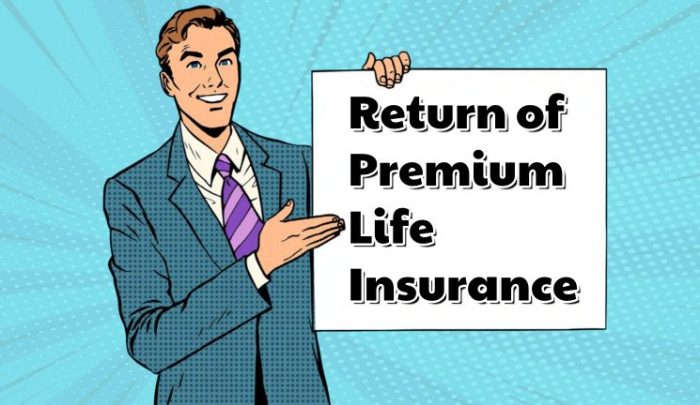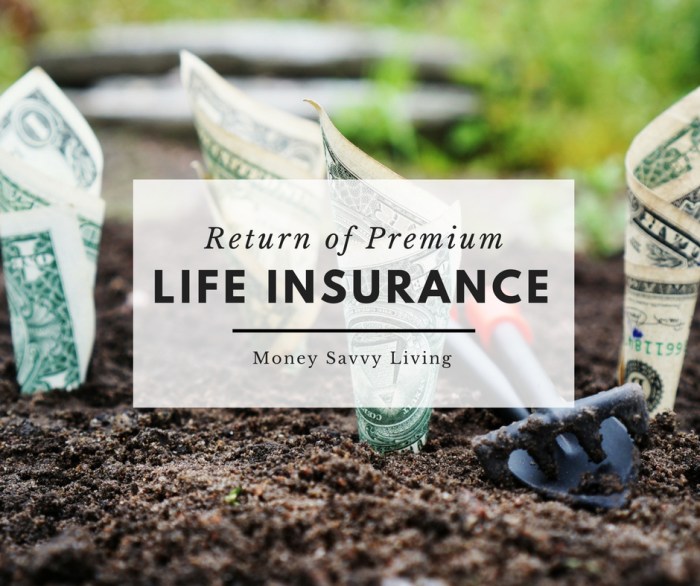Return of premium life insurance offers a unique proposition in the world of financial planning. Unlike traditional life insurance policies, which primarily focus on providing a death benefit, return of premium policies guarantee the return of all or a significant portion of your premiums if you outlive the policy term. This innovative approach combines the security of life insurance coverage with the potential for a substantial financial return, making it an attractive option for those seeking a blend of protection and investment.
This guide delves into the intricacies of return premium life insurance, exploring its mechanisms, costs, suitability, and potential benefits. We’ll examine how it differs from traditional policies, analyze its value proposition, and help you determine if it aligns with your individual financial goals and risk tolerance. We’ll also address common misconceptions and provide practical examples to illustrate the policy’s workings.
Defining Return of Premium Life Insurance

Return of Premium (ROP) life insurance is a type of life insurance policy that offers a unique benefit: the return of all or a significant portion of your premiums if you outlive the policy term. This contrasts sharply with traditional term or whole life policies, where premiums are essentially a one-way payment, regardless of the policyholder’s longevity. Understanding the nuances of ROP insurance is crucial for making informed decisions about your financial protection.
ROP policies function by accumulating a cash value component alongside the death benefit. This cash value grows over time, typically tax-deferred, and is ultimately returned to the policyholder if they survive the policy term. The specific terms and conditions, including the percentage of premiums returned and the timing of the return, vary significantly among insurers and policy types. Unlike traditional life insurance, which primarily focuses on providing a death benefit to beneficiaries, ROP policies provide a dual benefit: protection for loved ones in case of death and a financial return if the policyholder survives.
Key Features Distinguishing Return of Premium Life Insurance
Return of Premium life insurance distinguishes itself from traditional life insurance through several key characteristics. Firstly, the core promise of premium return is a defining feature. Secondly, the cost is generally higher than comparable term life insurance policies because of the built-in return-of-premium feature. Finally, the policy’s duration is usually for a specific term, often 10, 20, or 30 years, after which the premiums are returned (or a portion thereof). The absence of a cash value accumulation beyond the return-of-premium component also differentiates it from whole life or universal life insurance policies, which offer potential cash value growth irrespective of premium return features.
Scenarios Where Return of Premium Life Insurance is Beneficial
ROP insurance can be particularly advantageous in specific circumstances. For example, a young professional with a growing family might find it appealing as a way to secure their family’s financial future while also having the assurance of a premium refund if they remain healthy. Similarly, individuals who want a defined period of coverage and a guaranteed return of investment might choose this type of policy over other options. Consider a scenario where a 35-year-old parent purchases a 20-year ROP policy. If they survive the 20 years, they receive a significant sum, potentially usable for retirement planning or other financial goals. If, however, they pass away during the term, the death benefit goes to their family.
Comparison of Return of Premium Policies with Other Life Insurance Options
ROP policies offer a different risk-reward profile compared to other life insurance types. Compared to term life insurance, ROP policies are more expensive but offer the potential for premium return. In contrast to whole life or universal life insurance, ROP policies generally lack the potential for significant cash value growth beyond the return of premiums. The choice between these options hinges on individual financial goals and risk tolerance. For example, someone prioritizing maximum death benefit coverage at the lowest cost might choose term life insurance. However, someone valuing both coverage and a potential premium refund might prefer a ROP policy, accepting the higher premium cost.
How Return of Premium Works

Return of Premium (ROP) life insurance policies operate on a straightforward principle: if the policyholder survives the policy term, all or a significant portion of the premiums paid are returned. This differs from traditional life insurance, which primarily focuses on providing a death benefit. Understanding how this return mechanism functions is crucial for assessing the policy’s value proposition.
The return of premiums is typically structured as a lump-sum payment made to the policyholder upon the policy’s maturity date, provided they have maintained the policy in good standing throughout its term. This means consistent premium payments are required, and the policy must not be surrendered or lapsed prematurely. The specific terms and conditions governing the return, including the percentage of premiums returned and any applicable fees or deductions, are clearly Artikeld in the policy contract. It’s essential to carefully review this documentation before purchasing an ROP policy.
Premium Return Conditions and Timelines
The return of premiums is contingent upon the policyholder meeting several conditions. These conditions are usually spelled out explicitly in the policy document and often include maintaining consistent premium payments for the policy’s entire term, avoiding any lapses in coverage, and adhering to all other policy stipulations. The timeline for the return is typically tied to the policy’s maturity date, which is pre-defined at the time of purchase. For example, a 20-year ROP policy would return premiums upon the policyholder reaching the age of 20. Any additional riders or benefits added to the policy may influence the return timeline and the amount returned.
Factors Affecting the Return Amount
Several factors can influence the total amount of premiums returned. The most obvious is the total amount of premiums paid. Higher premiums generally lead to a larger return, provided all other conditions are met. However, the policy may also include deductions for fees, charges, or expenses. These deductions, often Artikeld in the policy’s fine print, can reduce the final return amount. Additionally, some policies may offer a partial return of premiums rather than a full return, which would naturally affect the total amount received. Finally, the insurer’s financial performance can indirectly influence the return, although this is less common and typically not a significant factor.
Hypothetical Scenario Illustrating Return of Premium
Let’s imagine Sarah purchases a 10-year ROP life insurance policy with an annual premium of $1,000. Over the 10-year period, she pays a total of $10,000 in premiums. Assuming the policy guarantees a full return of premiums and no deductions are applied, Sarah would receive a lump-sum payment of $10,000 at the end of the 10-year term, provided she has maintained the policy in good standing. However, if the policy stipulated a 90% return of premiums and there were $500 in administrative fees, Sarah would receive $9,000 – $500 = $8,500. This illustrates how policy specifics and potential deductions directly impact the final return amount.
Suitability and Target Audience

Return of premium life insurance, while offering an attractive proposition, isn’t a one-size-fits-all solution. Understanding the ideal profile of individuals who would benefit most is crucial for making an informed decision. This section explores the suitability of this type of policy across different financial situations, age groups, and income levels.
Return of premium life insurance is best suited for individuals who value financial security and want a safety net while also potentially recovering their premiums. The policy’s appeal lies in its dual nature: providing life insurance coverage and offering a potential return of premiums. This makes it a compelling option for those with a strong preference for financial planning and a desire for a tangible return on their investment.
Ideal Financial Situations for Return of Premium Policies
A return of premium policy is particularly appropriate for individuals with a healthy financial situation who are looking to protect their assets and provide for their dependents. This type of policy can be a valuable tool for estate planning, ensuring that a financial legacy is left behind while mitigating potential financial losses. For example, a high-net-worth individual with significant assets might find a return of premium policy advantageous as a way to protect their wealth and ensure a smooth transfer of assets to their heirs. Furthermore, individuals with substantial income and a long-term financial horizon often find this type of policy fits well within their overall financial strategy. It allows them to balance risk mitigation with potential premium recovery, maximizing their investment.
Suitability Across Age Groups and Income Levels
The suitability of a return of premium policy varies depending on age and income. Younger individuals with longer life expectancies and higher earning potential might find the premium costs more manageable and the long-term benefits more appealing. The longer timeframe allows for greater potential for premium return. Conversely, older individuals might find the premiums relatively higher due to their increased risk profile. Similarly, higher-income individuals might find the premiums less burdensome than those with lower incomes. However, even for those with lower incomes, if the premium cost is a manageable percentage of their disposable income, the long-term benefits and potential return could still be attractive. It’s important to carefully consider individual circumstances and financial goals before making a decision.
Situations Where Return of Premium Policies May Not Be Ideal
While return of premium policies offer several advantages, they might not be the best choice for everyone. Individuals who prioritize solely the lowest premium costs might find that term life insurance provides a more cost-effective solution for the same death benefit. Furthermore, if an individual’s primary concern is simply securing a high level of life insurance coverage at the lowest possible cost, a term life insurance policy may be a more suitable option. In addition, individuals with limited financial resources or those facing immediate financial challenges might find the premiums for a return of premium policy too high. The premiums, although potentially returned, represent a significant upfront financial commitment. Finally, someone with a shorter life expectancy might not benefit from the return of premium feature, as the premiums may not be fully returned before death.
Final Wrap-Up
Return of premium life insurance presents a compelling alternative to traditional life insurance, offering a unique combination of coverage and potential financial return. While the cost may be higher than standard term life insurance, the prospect of receiving back all premiums paid if you remain healthy throughout the policy term can be a significant advantage for many. Ultimately, the suitability of a return of premium policy depends on individual circumstances, financial goals, and risk appetite. Careful consideration of your needs and a thorough review of policy terms are crucial before making a decision.
User Queries
What happens if I die during the policy term?
Your beneficiaries will receive the death benefit, as specified in your policy.
Are there any tax implications for the returned premiums?
The tax treatment of returned premiums can vary depending on your location and specific policy details. Consult a tax professional for personalized advice.
Can I surrender my return of premium policy early?
Generally, surrendering a policy early will result in a loss of the potential return of premiums. Check your policy for specific surrender options and penalties.
How does the return of premium feature affect the death benefit?
The death benefit is typically the same as with a standard term life insurance policy of similar coverage, regardless of the return of premium feature. The returned premiums are separate from the death benefit payout.